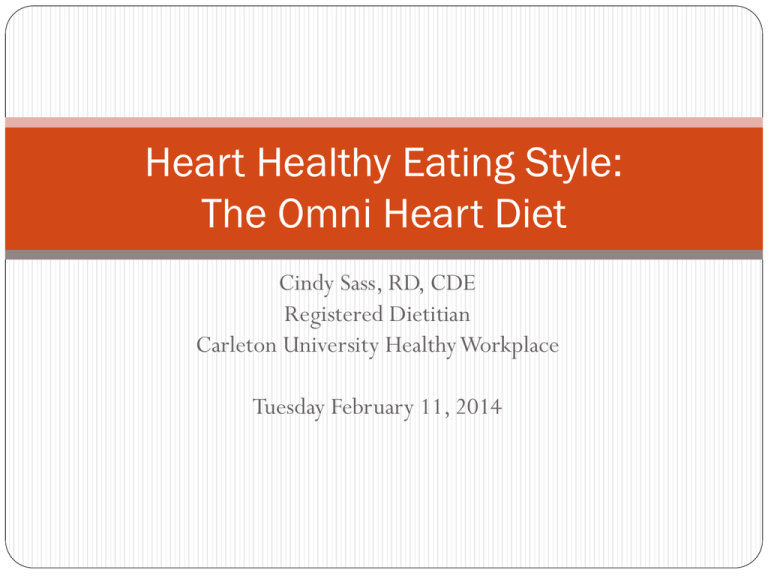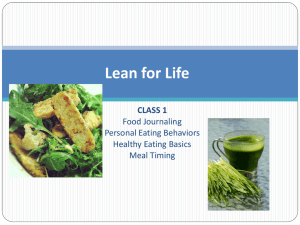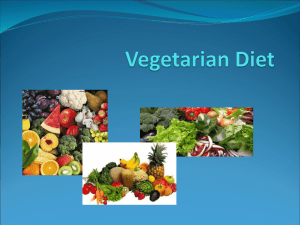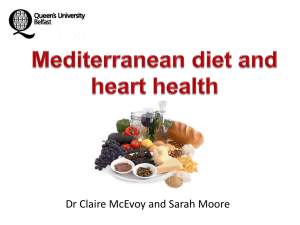PowerPoint - Carleton University
advertisement

Heart Healthy Eating Style: The Omni Heart Diet Cindy Sass, RD, CDE Registered Dietitian Carleton University Healthy Workplace Tuesday February 11, 2014 Cardiovascular Disease (CVD) in Canada Has been in decline Since 1952 the rate has declined by more than 75% Largely due to research, advances in surgical procedures, drugs and prevention efforts. But still... Heart attack and stroke are 2 of the 3 leading causes of death in Canada. Account for ~29 % of all deaths in Canada. Risk Factors for Heart Disease and Stroke Risk Factors Smoking Alcohol consumption Physical inactivity Obesity High blood pressure High blood cholesterol Diabetes Healthy Diets can lower the risk of CVD What does a healthy diet look like? Despite all of the diet books, food guides and expert advice, most people are still confused! Gluten free, Paleo, low carb, no carb, low fat, Aitkens? Heart Healthy Eating Omni Heart Study O- optimal M- macro N- nutrient I- intake For heart health Omni Heart Study diet Compared the effects of 3 heart healthy diet approaches. Based on variations of the DASH diet which is a vegetable and fruit rich diet. Each of the 3 diets was higher in one of the following: Carbohydrates - mostly from foods, containing a total of 5 tsp. of sugar a day. Protein – more than half from beans, nuts, seeds, tofu and other non – animal sources. Unsaturated fats - mostly from Canola and Olive oil. The diets were remarkably effective! Lowered blood pressure: By 13 to 16 points in people with hypertension, 8 points in people with pre-hypertension “The diets lowered blood pressure more than most Blood Pressure drugs. The diets were remarkably effective! Lowered LDL (bad) cholesterol Lowered damaging triglycerides Reduced the risk of heart disease and stroke over 10 years by 20-30%. What made the Omni heart diet so potent? Low levels of sodium? High levels of potassium? Low levels of saturated High levels of and trans fats? Low levels of added sugar? magnesium? High levels of calcium? High levels of fibre? And the winner is.... There was a tie between the omni heart diets higher in protein and saturated fat. Both were a little better at reducing heart disease risk than the higher carbohydrate diet. A Day’s Worth of Food The Omni Heart Diet 2000 calories Vegetables and fruit 11 servings per day Try: A main dish (4 cup) salad What is a serving – ½ cup raw, cooked vegetables 1 cup salad greens 1 piece fruit ½ cup fresh fruit ¼ cup dried fruit for lunch is 4 servings. 2 cups of stir fried veggies for supper is another 4 servings. Add 3 pieces of fruit, one for breakfast and 2 others for snacks and you’ve got 11 servings. Grains 4 servings per day: Try: What is a serving: ½ cup cereal with 1 slice of bread ½ cup cereal ½ cup cooked pasta or rice breakfast 2 slices of bread with lunch ½ cup rice or pasta with dinner This adds up to 4 servings Choose whole grains whenever possible Low – Fat Dairy 2 servings per day Try: A serving is: ½ cup of milk with cereal 1 cup skim or 1% milk, 1.5 oz (40 grams) cheese, 1 cup yogurt for breakfast 6 oz. yogurt for lunch or a snack 1 oz cheese for salad or vegetables Legumes and Nuts 2 servings per day Try: What is 1 serving: You can have ½ cup of ¼ cup of nuts ½ cup cooked beans 120 grams tofu beans on salad or with dinner and ¼ cup of nuts on cereal, salad, grains or as a snack. That comes to 2 servings. Poultry, Fish and Meat 1 serving per day Try: What is a serving: Start with 6 oz of raw ¼ lb cooked or 120 grams cooked or 4 ounces poultry, fish or meat to get 4 ounces cooked. That is about the size of a deck of cards. Desserts and Sweets 2 servings per day What is a serving: 1 small cookie 1 tsp. of sugar Try: Count each oreo sized cookie as about 1 tsp of sugar. Many breakfast cereal have 1-2 tsp of sugar Note: a 175 ml fruit yogurt or ½ cup of ice cream has 4-5 tsp of sugar. Oils and Fats 2 servings per day What is a serving? 1 Tbsp. of oil 1 Tbsp. of margarine or mayonnaise Try: Use 1 Tbsp. to saute vegetables and 1 Tbsp. in your salad dressing (2 Tbsp. of dressing usually contain 1 Tbsp. of oil) Wild Card 1 Serving per day Try: 1 more serving of poultry About 120 calories’ worth fish meat, oils and fats, grains, or desserts and sweets of any category previous. The tricky part.. The tricky part is summing up a entire diet in simple, easy to remember advice You probably won’t follow this diet every single meal Think of it as an ideal. Rules of the Road Make vegetables a main course. Fill at least half of your plate at lunch and dinner. Have fruit for snacks or with breakfast and lunch. Make vegetables part of your main dish like stir fry, vegetable curry, vegetable fajitas. Keep saturated fat and cholesterol low This means just a small portion of poultry, fish, lean meat per day. Use more beans, tofu. Use eggs and low fat cheese sparingly. Egg whites are ok. Don’t overdo grains Limited to 4 servings a day if you are shooting for 2000 calories, 3 if you are shooting for 1600. A serving is a thin slice of bread, not a 4 oz. Bagel. ½ cup cooked is not much, it’s the volume of 2 golf balls. Minimize added sugar A 2000 calorie diet allows for 2 tsp. (8 grams) of added sugar a day. There’s no room for more empty calories. Keep a lid on sodium Avoid high sodium processed foods like: Deli meats Canned soups Heat and serve entrees Chips, snack foods Eat Beans and Nuts In the Omni heart study people reported feeling more full when they ate a diet rich in beans and nuts. Add beans to soups, stews, casseroles, stir fries. Have ¼ cup nuts on your cereal, as a snack. Don’t over do nuts, their calories can add up quickly. Eat Real Food Not Junk! Notice what is missing in this diet? Sweets, cookies, cakes Big bowls of pasta Big bagels, muffins Most pizzas, wraps, burritos, Panini sandwiches are too big Gone are granola bars, energy bars, pita chips and junk disguised as health foods Think of them as an occasional splurge! In Conclusion You probably won’t follow this diet every single meal Think of it as an ideal Take parts of this diet, what seems easiest to you and start making changes Change is a process accomplished over time. Questions?







